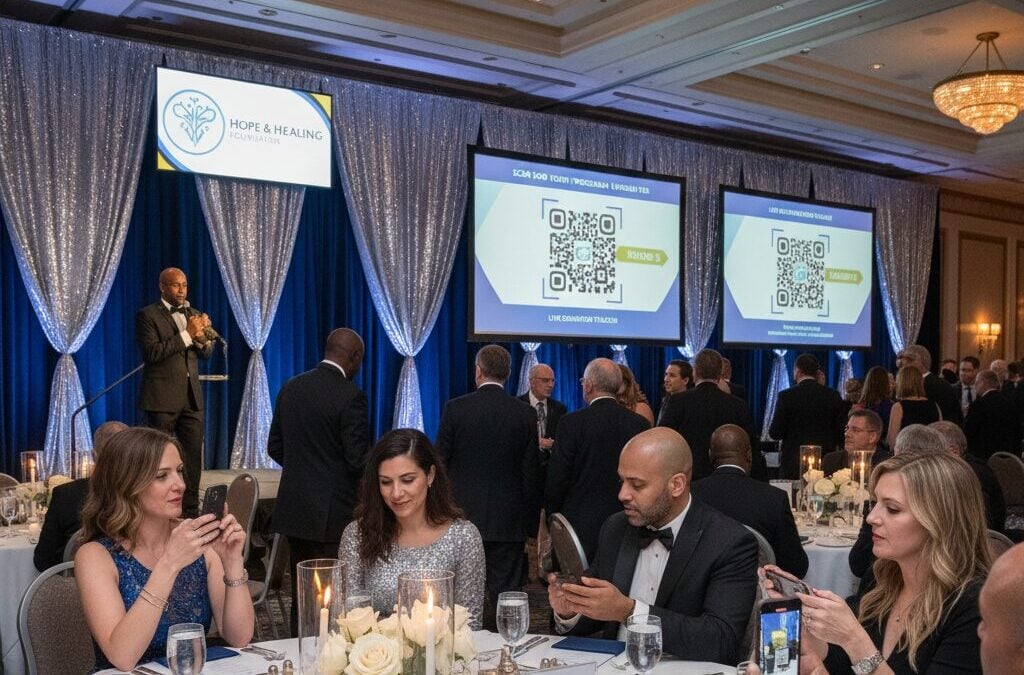QR Codes Are Everywhere—And They’re Easier Than You Think
QR codes used to feel like futuristic tech. Today, they’re on menus, billboards, flyers, and even church bulletins. For nonprofits, that means people are already trained to scan them. If your organization isn’t using QR codes to make giving and engagement easier, you’re leaving money and momentum on the table.
Imagine this: at your fundraising dinner, instead of asking guests to type in a long URL or mail a check later, you put a QR code on each table. Supporters simply pull out their phones, scan, and give. That one small adjustment can unlock real-time donations when people are most inspired.
Why QR Codes Work So Well for Nonprofits
QR codes remove barriers. Donors don’t need to search your website or remember where to click—they just scan. This instant access creates less friction and more generosity.
Here’s how nonprofits commonly use them:
- Donation forms: Print a QR code on flyers or postcards that takes supporters directly to your giving page.
- Event check-ins: Attendees scan at the door for instant registration and ticket validation.
- Storytelling: Add QR codes to newsletters that link to videos showing how donations are making a difference.
- Volunteer sign-ups: A simple scan leads people straight to your signup form.
Think of them like doorways—easy, quick, and always open. When people are moved to act, the QR code gives them an immediate way to do it.
Boosting Donor Engagement With QR Codes
The real magic isn’t just in the code—it’s in what happens after the scan. Nonprofits that integrate QR codes into their donation flow are seeing stronger engagement because the process feels effortless. If you want to dive deeper, the article on why QR codes are transformative for donor engagement explains how a simple code can make giving faster and more personal.
Picture a local food pantry placing QR codes on grocery bags handed out to families. Recipients who appreciate the support can scan the code later to give back or share the code with friends. That one little square connects gratitude with generosity.
QR Codes in Marketing Campaigns
Marketing for nonprofits often relies on print—flyers, posters, mailers. The problem is print can’t click. A QR code solves that by bridging offline and online worlds.
Examples:
- A poster at the park about your animal shelter includes a QR code to adopt a pet.
- A mailer about your building fund directs donors straight to a landing page with progress photos.
- A community event banner lets guests scan to follow your organization on social media.
Every scan is trackable. That means you’re not guessing how well your flyer worked—you know. And you can adjust your campaigns accordingly.
Why Your QR Platform Matters
Not all QR tools are created equal. Free generators may seem convenient, but they lack tracking, customization, and reliability. For nonprofits, that’s risky—you can’t afford broken links or generic branding. That’s why many organizations are moving to PairedQR, a platform built to handle both marketing and donation needs with nonprofit budgets in mind.
Unlike generic tools, PairedQR lets you manage campaigns, track scans, and customize codes to match your brand. There’s even a full breakdown of why PairedQR beats Bitly and QR Code Monkey if you want to compare features head-to-head.
Making QR Codes Part of Everyday Outreach
The beauty of QR codes is that they’re low-cost and flexible. You don’t need a tech team to make them work. Once you create your codes, you can place them anywhere:
- Print bulletins, newsletters, or programs
- T-shirts and tote bags for events
- Presentation slides during fundraising appeals
- Email signatures for staff
Consider how your audience already interacts with your materials, then add a QR code as the next logical step. When donors don’t have to think, they act.
Real-World Picture: The Church Fundraiser
Imagine a small-town church hosting a Sunday bake sale to raise money for youth camp. In the past, they collected cash in a jar. This year, they print a QR code on a simple sign at the table. One young parent scans it, donates on the spot, and shares the code with a relative who lives out of state. Suddenly, the bake sale isn’t limited to who has cash on hand—it’s wide open to anyone with a smartphone.
That’s the power of taking your offline efforts online with just one square inch of printed space.
Tips for Using QR Codes Effectively
- Test before launch: Always scan your code yourself to make sure it works.
- Use clear calls to action: Add simple text like “Scan to Donate” or “Scan to Volunteer.”
- Track results: Choose a platform that gives you analytics so you know what’s working.
- Keep pages mobile-friendly: Most people will scan on their phones, so your landing page must be easy to use on small screens.
The Bottom Line for Nonprofits
QR codes aren’t a tech trend—they’re a practical tool your supporters already understand. By making giving and engagement as easy as a scan, you meet donors where they are and remove excuses for not acting. Whether you’re running a large capital campaign or a small community fundraiser, QR codes can make the difference between a missed opportunity and a new stream of support.
Nonprofits don’t need to overcomplicate this. Start with one QR code linked to your donation page, place it on your next flyer or event program, and watch what happens. The return often speaks for itself.


Recent Comments